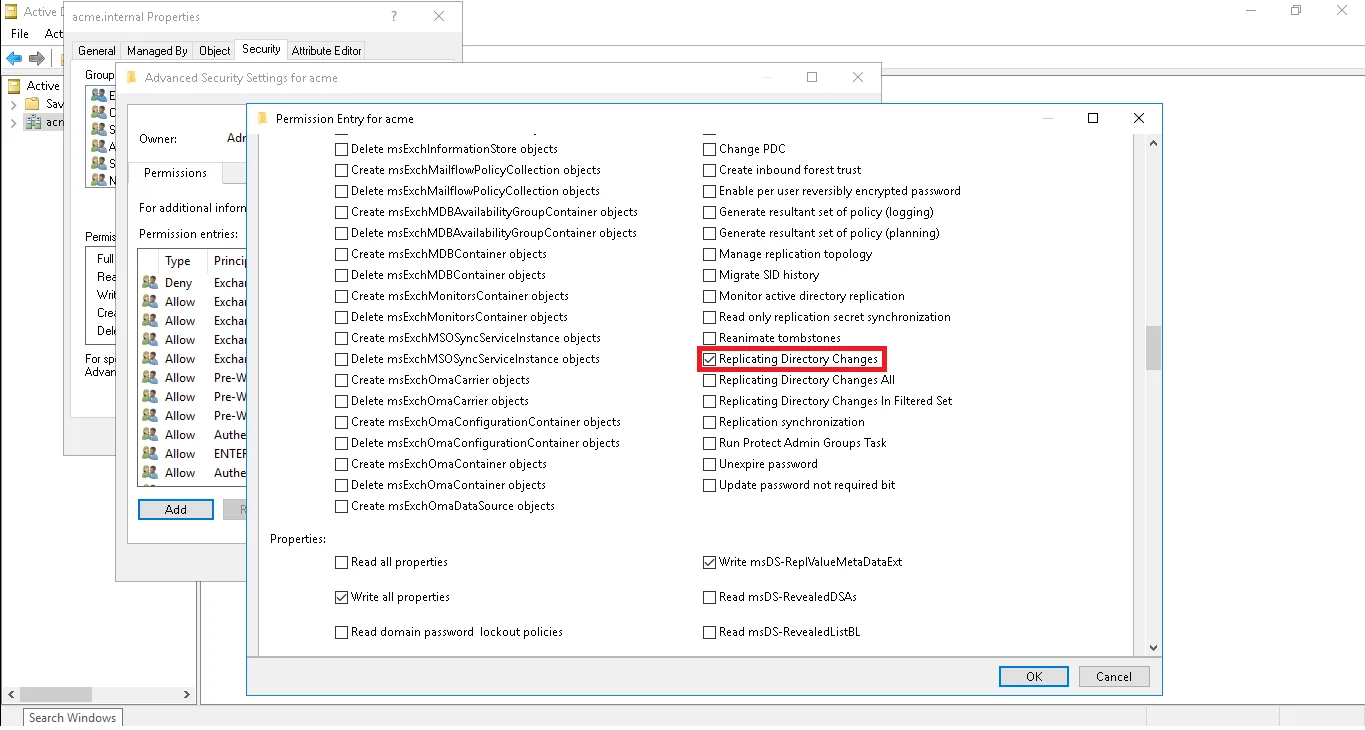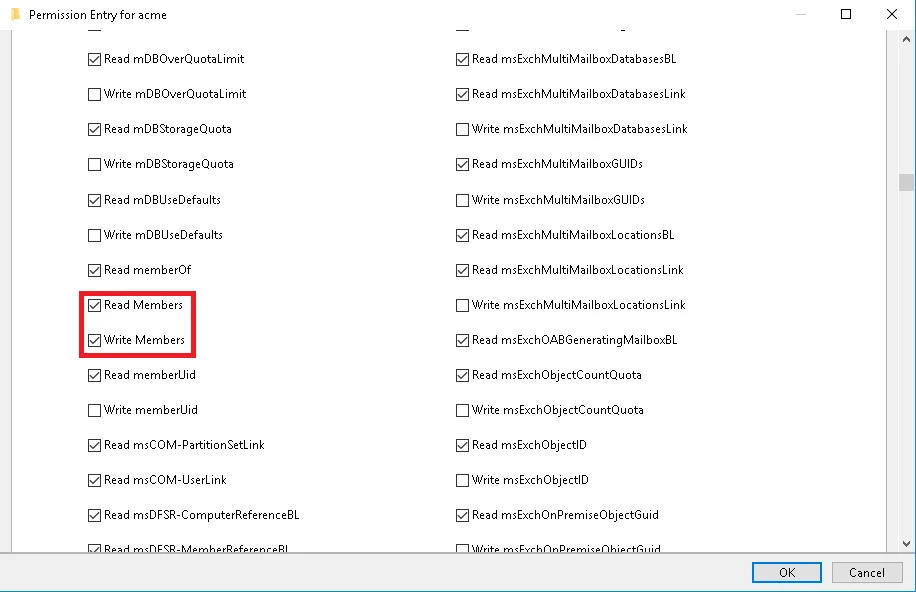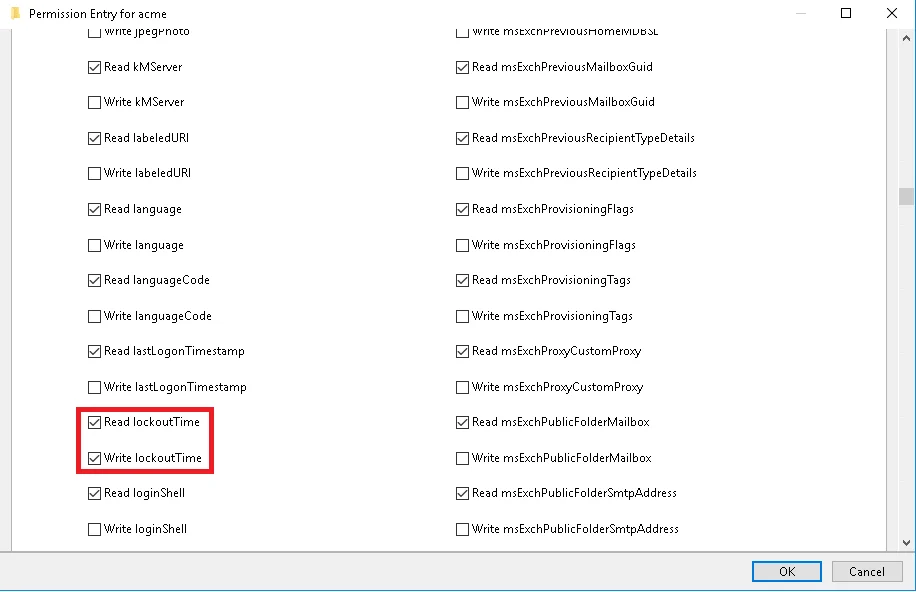Active Directory
This connector exports and fulfills users and groups from/to an Active Directory instance.
This page is about Directory/Active Directory.
Overview
Active Directory is a directory service developed by Microsoft for Windows domain networks. The Active Directory connector exports Active Directory (AD) entries to Usercube's resource repository. This connector also enables automated provisioning from the resource repository to the AD.
Prerequisites
Implementing this connector requires:
- reading first the appsettings documentation;
- opening the LDAP feed from Usercube's server to the Active Directory, with the ports 389 for LDAP and 636 for LDAPS;
- a service account with reading and writing permissions on the target Active Directory instance. It means that the Replicating Directory Changes rights are required for the service account, but also for the Active Directory root and the AD children. See the instructions below;
- enabling rights inheritance in the Advanced Security Settings.
Enable Active Directory Permissions
To enable permissions, the Active Directory administrator must open the Advanced Security Settings dialog box for the domain root and select the Replicating Directory Changes check box from the list.



Also, in order to change groups' membership, in the Applies field, select
Descendent Group object and select the Read Members and Write Members check boxes from the
list.

If you want the Reset Password capabilities, in the Applies field, select Descendent User object
and select the Read lockoutTime and Write lockoutTime check boxes from the list.

Administrator rights must not be granted to the service account. Doing otherwise would create a security breach. Administrator rights must only be granted to the target perimeter.
Export
For a configured set of Active Directory entries, this connector exports all attributes from the connector's configuration to CSV files.
The export is executed by a job from the UI, or via Usercube-Export-ActiveDirectory.exe in the
command prompt.
Configuration
This process is configured through a
connection
in the UI and/or the XML configuration, and in the appsettings.agent.json > Connections section:
appsettings.agent.json
{
...
"Connections": {
...
"<ConnectionIdentifier>": {
...
}
}
}
The identifier of the connection and thus the name of the subsection must:
- be unique.
- not begin with a digit.
- not contain
<,>,:,",/,\,|,?,*and_.
The following example configures a connection to the Active Directory Domain Controller
contoso.server.comusing Basic Authentication with BaseDN, Login, Password withEnableSSLfor all entries ("Filter": "(objectclass=*)"):appsettings.agent.json
{
...
"Connections": {
"ADExport": {
"Filter": "(objectclass=*)",
"Servers": [
{
"Server": "contoso.server.com",
"BaseDN": "DC=contoso,DC=com"
}
],
"AuthType": "Basic",
"AsAdLds": false,
"EnableSSL": true,
"Login": "Contoso",
"NoSigning": false,
"Password": "ContOso$123456789",
"RetryDelay": 10
}
}
}
Setting attributes
| Name | Details |
|---|---|
| Servers required | Type Server List Description List of pairs that define the target servers, made of: - Server: domain controller URL. - BaseDN: base Distinguished Name used to connect to the related server. |
| AsAdLds optional | Type Boolean Description True to state the managed system as an AD LDS. Info: used for extracting the schema through the connection screen. |
| --- | --- |
| EnableSSL optional | Type Boolean Description True to enable SSL protocol for authentication requests. Note: recommended when using AuthType set to Basic because basic authentication packets are not encrypted by default. Info: SSL is not available on Linux. |
| NoSigning optional | Type Boolean Description True to disable Kerberos encryption. |
| --- | --- |
| AuthType default value: Negotiate | Type String Description Authentication method used by Usercube to authenticate to the server. Access is granted to the target domain controller: Anonymous - without any login/password; Basic - via the BaseDN, Login and Password attributes; Negotiate - via GSS-API negotiations with the Kerberos mechanism used for authentication. |
| Login optional | Type String Description Login used by Usercube for basic authentication. Note: required when AuthType is set to Basic. |
| Password optional | Type String Description Password used by Usercube for basic authentication. Note: required when AuthType is set to Basic. |
| --- | --- |
| Filter required | Type String Description Value that filters out the corresponding entries from the AD instance which will not be exported. Only non-filtered entries are exported. The filter value complies with Microsoft's search filter syntax. |
| RetryDelay optional | Type Int32 Description Time (in milliseconds) after which Usercube retries a timeout request. |
| RequestTimeout optional | Type Int32 Description Time (in seconds) after which a request faces a timeout. |
| ConnectionTimeout optional | Type Int32 Description Time (in seconds) after which a connection faces a timeout. |
Output details
This connector is meant to generate:
-
a file named
<connectionIdentifier>_entries.csv, with one column for each property having aConnectionColumnand each property without it but used in an entity association;Any property can be exported in a specific format when specified. See more details.
-
an additional file for each related table other than entries;
-
a cookie file named
<connectionIdentifier>_cookie.bin, containing the time of the last export in order to perform incremental exports.Most exports can be run in complete mode, where the CSV files will contain all entries, or in incremental mode, where CSV files will contain only the entries which have been modified since the last synchronization.
A task can use the
IgnoreCookieFileboolean property, and a command line (with an executable) can use the option--ignore-cookies.
The CSV files are stored in the ExportOutput folder, and the cookie file in the ExportCookies folder.
For example, with the following configuration example:
<EntityType Identifier="AD_Entry" DisplayName_L1="AD - Entry" > <Property Identifier="dn" DisplayName_L1="dn" IsKey="true" TargetColumnIndex="0" Type="String" /> <Property Identifier="objectCategory" DisplayName_L1="objectCategory" TargetColumnIndex="4" Type="String" /> <Property Identifier="objectGuid" DisplayName_L1="objectGuid" TargetColumnIndex="3" Type="String" IsKey="true" /> <Property Identifier="objectSid" DisplayName_L1="objectSid" TargetColumnIndex="9" Type="String" /> <Property Identifier="pwdLastSet" DisplayName_L1="pwdLastSet" TargetColumnIndex="13" Type="String" /> <Property Identifier="thumbnailPhoto" DisplayName_L1="thumbnailPhoto" Type="Binary" /> <Property Identifier="ParentDn" DisplayName_L1="ParentDN" Type="ForeignKey" TargetColumnIndex="128" /> <Property Identifier="children" DisplayName_L1="children" Type="ForeignKey" /> <Property Identifier="Member" DisplayName_L1="Member" Type="ForeignKey" /> <Property Identifier="memberOf" DisplayName_L1="memberOf" Type="ForeignKey"/></EntityType><EntityTypeMapping Identifier="AD_Entry" Connector="AD" ConnectionTable="ADExport_entries"> <Property Identifier="dn" ConnectionColumn="dn" IsUniqueKey="true" /> <Property Identifier="objectCategory" ConnectionColumn="objectCategory" Format="rdn" /> <Property Identifier="objectGuid" ConnectionColumn="objectGuid" IsPrimaryKey="true" Format="guid" /> <Property Identifier="objectSid" ConnectionColumn="objectSid" IsUniqueKey="true" Format="sid"/> <Property Identifier="pwdLastSet" ConnectionColumn="pwdLastSet" Format="1601date" /> <Property Identifier="thumbnailPhoto" ConnectionColumn="thumbnailPhoto" Format="binary" /></EntityTypeMapping><EntityAssociation Identifier="AD_Entry_parentdn" DisplayName_L1="Parent DN" IsProperty1Collection="true" Property2="AD_Entry:ParentDn" Property1="AD_Entry:children" /><EntityAssociation Identifier="AD_Entry_member" DisplayName_L1="Member" IsProperty1Collection="true" IsProperty2Collection="true" Property1="AD_Entry:Member" Property2="AD_Entry:memberOf" /><EntityAssociationMapping Identifier="AD_Entry_parentdn" Column2="dn" Column1="parentdn" ConnectionTable="ADExport_entries" EntityPropertyMapping1="AD_Entry:dn" EntityPropertyMapping2="AD_Entry:dn" Connector="AD" /><EntityAssociationMapping Identifier="AD_Entry_member" Column1="dn" Column2="member" ConnectionTable="ADExport_members" EntityPropertyMapping1="AD_Entry:dn" EntityPropertyMapping2="AD_Entry:dn" Connector="AD" />We would have
C:/identitymanagerContoso/Temp/ExportOutput/ADExport_entries.csvwith a column for each scalar property:ADExport_entries.csv
command,dn,objectCategory,objectGuid,objectSid,pwdLastSet,thumbnailPhoto,parentdn
...Also,
ADExport_memberasConnectionTablein a mapping will trigger the generation of the fileC:/identitymanagerContoso/Temp/ExportOutput/ADExport_member.csvwithmemberas link attribute:ADExport_member.csv
command,dn,member
...And
C:/identitymanagerContoso/Work/ExportCookies/ADExport_cookie.bin.
Synchronize multiple forests
This connector can export resources from multiple forests trusted by the same AD domain.
It requires specifying the Server and BaseDN pairs in Servers for all the forests used as source for the export.
Each BaseDN will generate a cookie file, but the entries from all BaseDN properties will be written to the same CSV file.
The following example exports data from two sources: both on the same Server (
contoso.server.com), but on two different BaseDNs (DC=contoso,DC=comandDC=defense,DC=contoso,DC=com).appsettings.agent.json
{
...
"Connections": {
"ADExport": {
"Servers": [
{
"Server": "contoso.server.com",
"BaseDN": "DC=contoso,DC=com"
},
{
"Server": "contoso.server.com",
"BaseDN": "DC=defense,DC=contoso,DC=com"
}
],
"AuthType": "Basic",
"Login": "Contoso",
"Password": "ContOso$123456789",
"Filter": "(objectclass=*)",
"EnableSSL": "true"
}
}
}The export creates two cookie files:
ADExport_cookie_0.binfor the first BaseDN, andADExport_cookie_1.binfor the second BaseDN, but the entries of both BaseDN properties will be written inADExport_entries.csv.
Fulfill
This connector writes to the Active Directory, to create, update and delete entries, initiated manually through the UI or automatically by enforcing the policy.
Configuration
Same as for export, fulfill is configured through connections.
The following example connects to an AD LDS system located at
contoso.server.com.appsettings.agent.json
{
...
"Connections": {
...
"ADFulfillment": {
"Servers": [
{
"Server": "contoso.server.com",
"BaseDN": "DC=contoso,DC=com"
}
],
"AuthType": "Basic",
"AsAdLds": "true",
"EnableSSL": true,
"Login": "Contoso",
"NoSigning": false,
"Password": "ContOso$123456789",
}
}
}
Setting attributes
| Name | Details |
|---|---|
| Servers required | Type Server List Description List of pairs that define the target servers, made of: - Server: domain controller URL. - BaseDN: base Distinguished Name used to connect to the related server. |
| AsAdLds optional | Type Boolean Description True to state the managed system as an AD LDS. Info: used for extracting the schema through the connection screen. |
| --- | --- |
| EnableSSL optional | Type Boolean Description True to enable SSL protocol for authentication requests. Note: recommended when using AuthType set to Basic because basic authentication packets are not encrypted by default. Info: SSL is not available on Linux. |
| NoSigning optional | Type Boolean Description True to disable Kerberos encryption. |
| --- | --- |
| AuthType default value: Negotiate | Type String Description Authentication method used by Usercube to authenticate to the server. Access is granted to the target domain controller: Anonymous - without any login/password; Basic - via the BaseDN, Login and Password attributes; Negotiate - via GSS-API negotiations with the Kerberos mechanism used for authentication. |
| Login optional | Type String Description Login used by Usercube for basic authentication. Note: required when AuthType is set to Basic. |
| Password optional | Type String Description Password used by Usercube for basic authentication. Note: required when AuthType is set to Basic. |
Output details
This connector can create a new resource, and update and delete an existing resource via the UI.
A new resource is created with the state disabled, corresponding to the useraccountcontrol
value 514. When it is approved, its disabled state is removed and the useraccountcontrol
value becomes 512.
Provision multiple forests
Same as for export, this connector can fulfill resources to multiple forests trusted by the same AD domain, by specifying the Server and BaseDN pairs in Servers for all forests.
The following example fulfills data to two targets: both on the same Server (
contoso.server.com), but on two different BaseDNs (DC=contoso,DC=comandDC=defense,DC=contoso,DC=com).appsettings.agent.json
{
...
"Connections": {
...
"ADFulfillment": {
"Servers": [
{
"Server": "contoso.server.com",
"BaseDN": "DC=contoso,DC=com"
},
{
"Server": "contoso.server.com",
"BaseDN": "DC=defense,DC=contoso,DC=com"
}
],
"AuthType": "Basic",
"Login": "Contoso",
"Password": "ContOso$123456789",
"AsAdLds": "true"
}
}
}
Add attributes to the requests
Some systems using the LDAP protocol require additional attributes in the creation and/or update requests.
If these attributes are not synchronized in Usercube, then they cannot be computed and provided by
scalar rules or navigation rules. In this case, they can be given as arguments in the provisioning
order, through the ResourceType's ArgumentsExpression.
The following example adds the attribute
descriptionwith a value depending on what is modified:
<ResourceType Identifier="LDAP_Entry_NominativeUser" DisplayName_L1="LDAP User (nominative)" Policy="Default" TargetEntityType="LDAP_Entry" Category="Accounts" SourceEntityType="Directory_User" ApprovalWorkflowType="One" HideOnSimplifiedView="true"
ArgumentsExpression="C#:resource:
var arguments = new System.Collections.Generic.Dictionary<string, string>();
if (provisioningOrder.HasChanged("cn")) {
arguments.Add("description", "This entry's login has been modified by Usercube.");
}
else if (provisioningOrder.HasChanged("mail")) {
arguments.Add("description", "This entry's email has been modified by Usercube.");
}
else {
arguments.Add("description", "This entry has been modified by Usercube.");
}
return arguments;">
<ScalarRule Property="givenName" Binding="FirstName" /> <ScalarRule Property="cn" Binding="Login" /> <ScalarRule Property="sn" Binding="LastName" /> <ScalarRule Property="employeeNumber" Binding="EmployeeId" /></ResourceType>
Authentication
Password reset
See how to configure password reset settings.
Credential protection
Data protection can be ensured through:
-
RSA encryption, configured in the
appsettings.encrypted.agent.jsonfile; -
an Azure Key Vault safe;
-
a CyberArk Vault able to store Active Directory's
Login,PasswordandServer.
Active Directory
Manages users and groups in Active Directory. This package supports incremental synchronization with the DirSync mechanism.
| Package Characteristics | Value |
|---|---|
| Display Name | Directory/Active Directory |
| Identifier | Usercube.AD@0000001 |
| Export | Usercube-Export-ActiveDirectory.dll |
| Fulfill | Usercube-Fulfill-Ldap.dll |
| Has Incremental Mode | True |
| Publisher | Usercube |